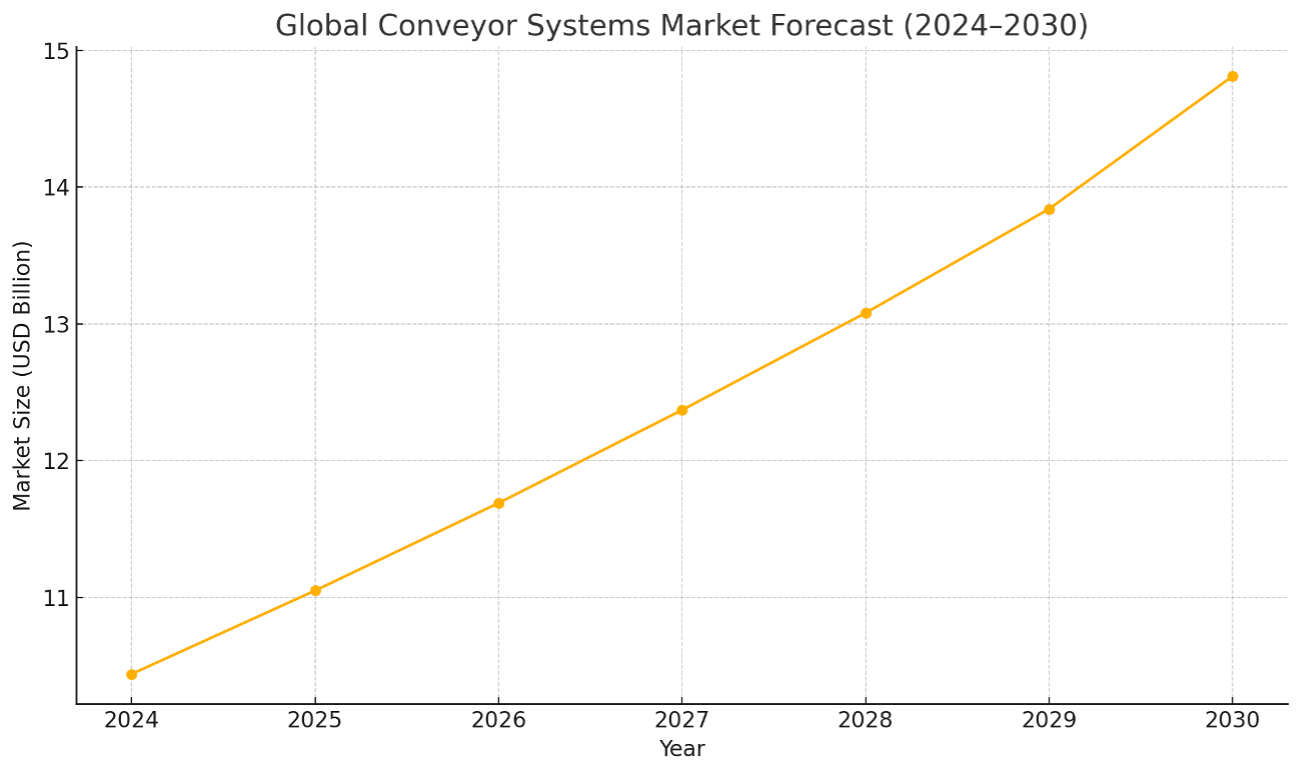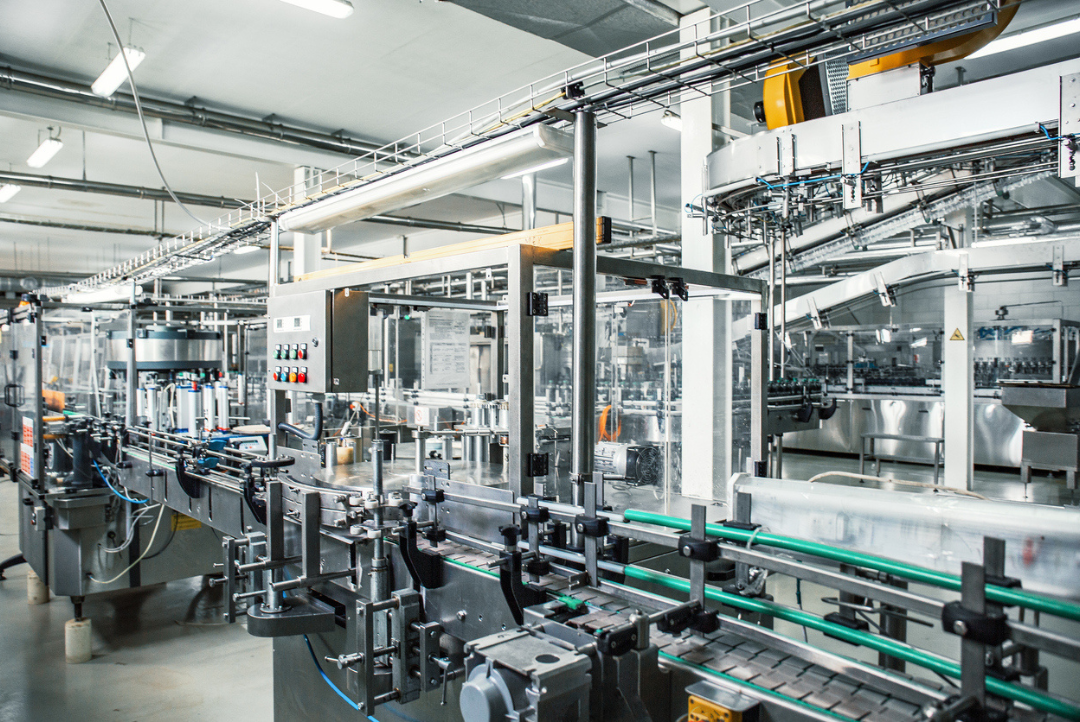The global conveyor systems and assembly solutions manufacturing markets are set for robust growth through 2035, driven by automation trends, increasing industrialization, and rising demand for streamlined material handling and production processes.
With expanding use cases across automotive, retail, food & beverage, aviation, and now cosmetics and personal care, the market is evolving toward greater precision, speed, and adaptability.
Conveyor Systems Market
Conveyor systems are the backbone of high-efficiency production and logistics environments. Used to transport materials and products across manufacturing lines, warehouses, and packaging facilities, they are widely adopted across industries ranging from e-commerce to consumer goods manufacturing.
The global conveyor systems market is projected to grow from USD 10.44 billion in 2024 to USD 14.81 billion by 2030, achieving a CAGR of 6.0%. This expansion is attributed to increasing investments in automated material handling, warehouse optimization, and just-in-time production strategies across sectors.

Cosmetics & Personal Care Spotlight
The cosmetics and personal care industry is emerging as a key growth area for conveyor technologies. As global beauty brands shift toward automated packaging, filling, and labeling systems, conveyors tailored for cleanroom environments and gentle product handling are in high demand.
These systems are:
- Built with sanitary designs to meet hygiene standards
- Engineered for small batch sizes and high SKU variation
- Integrated with vision systems and quality control sensors
From lipstick and lotion bottling to fragrance packaging and skincare labeling, conveyor systems support scalable and compliant production for a market increasingly driven by e-commerce and personalization.
Assembly Solutions Manufacturing Market
The assembly automation market, which includes robotic arms, pick-and-place systems, automated workstations, and vision-integrated solutions, is poised for rapid growth. The market size is expected to rise from USD 52.80 billion in 2023 to USD 143.37 billion by 2032, reflecting a CAGR of 13.30%.
Key Sectors Driving Demand
- Automotive: Electrification and modular vehicle design are accelerating demand for flexible and reconfigurable assembly lines.
- Electronics: High-volume, low-margin production requires precision automation and defect minimization.
- Consumer goods: Packaging innovations and mass customization need versatile, fast-changing assembly setups.
- Cosmetics & Personal Care: Automated assembly is increasingly used for:
-
- Pump and cap application
- Custom labeling and wrapping
- Single-dose unit production
- Tamper-proof packaging
-
Automation not only improves consistency but ensures compliance with industry standards for hygiene and product safety.

Market Drivers and Trends
- Industry 4.0 and Smart Manufacturing – The rise of AI, IoT, and machine vision technologies is transforming conveyor and assembly systems into intelligent, self-optimizing platforms. Predictive maintenance, real-time analytics, and robotic integration are becoming standard. The smart manufacturing market, projected to grow from USD 230.2 billion in 2024 to USD 1.1 trillion by 2035 (CAGR of 15.25%), is enabling rapid adoption of such innovations across manufacturing environments.
- Consumer-Led Demand for Customization – Personalization trends—particularly in beauty and wellness—require systems that can handle rapid product changeovers, multi-format packaging, and micro-batch runs. Modular conveyors and assembly lines are increasingly critical in these settings.
- Sustainability and ESG Compliance – Many companies are transitioning to energy-efficient systems, low-waste packaging, and cleanroom-capable equipment. Conveyor and assembly technologies that support these goals are becoming key procurement priorities, especially in food, pharma, and beauty sectors.
Mergers & Acquisitions: Growth Through Consolidation
Strategic M&A activity is expected to be a strong driver of market expansion through 2035:
- OEMs and integrators are acquiring niche automation firms to enhance their capabilities in industries like cosmetics, food, and pharma.
- Private equity firms are showing growing interest in conveyor and assembly solution providers, especially those with recurring revenue from servicing and retrofits.
- Vertical integration by consumer brands (e.g., personal care companies bringing packaging lines in-house) is accelerating.
The global M&A market for this sector is forecasted to grow at a CAGR of 8–10%, driven by the need for smart capabilities, compliance, and scale.
Regional Insights
- North America: Leading the market in high-tech assembly solutions and high-throughput conveyor applications, particularly in cosmetics, automotive, and logistics.
- Europe: Strong focus on regulatory compliance, sustainability, and precision automation, especially in food & personal care manufacturing.
- Asia-Pacific: Rapid growth fueled by expanding consumer demand, industrial automation in China and India, and a booming beauty and e-commerce ecosystem.
Conclusion
The conveyor systems and assembly automation markets are positioned for strong, sustained growth through 2035, driven by innovation, customization, and compliance needs across industries. The inclusion of high-growth sectors like cosmetics and personal care is further expanding the opportunity landscape. Businesses investing in smart, hygienic, and modular automation solutions, backed by strategic M&A, will be well-positioned to lead in this evolving market.
Invitation
If you are a manufacturer in these sectors considering retirement or a merger to achieve growth, we invite you to learn about our valuation process. Because we are solely manufacturing-focused, our valuations look beyond the balance sheet at over 175 different data points. Our valuations are typically higher than other firms and backed by over 30 years of successful transaction history. Learn more HERE.

